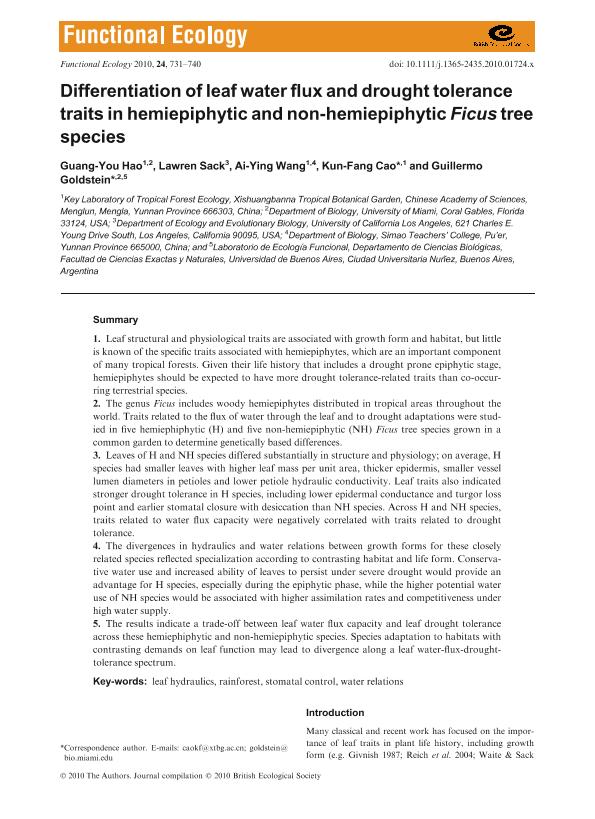Artículo
Differentiation of leaf water flux and drought tolerance traits in hemiepiphytic and non-hemiepiphytic Ficus tree species
Fecha de publicación:
08/2010
Editorial:
Wiley Blackwell Publishing, Inc
Revista:
Functional Ecology
ISSN:
0269-8463
Idioma:
Inglés
Tipo de recurso:
Artículo publicado
Clasificación temática:
Resumen
1. Leaf structural and physiological traits are associated with growth form and habitat, but little is known of the specific traits associated with hemiepiphytes, which are an important component of many tropical forests. Given their life history that includes a drought prone epiphytic stage, hemiepiphytes should be expected to have more drought tolerance-related traits than co-occurring terrestrial species. 2. The genus Ficus includes woody hemiepiphytes distributed in tropical areas throughout the world. Traits related to the flux of water through the leaf and to drought adaptations were studied in five hemiephiphytic (H) and five non-hemiepiphytic (NH) Ficus tree species grown in a common garden to determine genetically based differences. 3. Leaves of H and NH species differed substantially in structure and physiology; on average, H species had smaller leaves with higher leaf mass per unit area, thicker epidermis, smaller vessel lumen diameters in petioles and lower petiole hydraulic conductivity. Leaf traits also indicated stronger drought tolerance in H species, including lower epidermal conductance and turgor loss point and earlier stomatal closure with desiccation than NH species. Across H and NH species, traits related to water flux capacity were negatively correlated with traits related to drought tolerance. 4. The divergences in hydraulics and water relations between growth forms for these closely related species reflected specialization according to contrasting habitat and life form. Conservative water use and increased ability of leaves to persist under severe drought would provide an advantage for H species, especially during the epiphytic phase, while the higher potential water use of NH species would be associated with higher assimilation rates and competitiveness under high water supply. 5. The results indicate a trade-off between leaf water flux capacity and leaf drought tolerance across these hemiephiphytic and non-hemiepiphytic species. Species adaptation to habitats with contrasting demands on leaf function may lead to divergence along a leaf water-flux-drought-tolerance spectrum. © 2010 The Authors. Journal compilation © 2010 British Ecological Society.
Palabras clave:
Leaf Hydraulics
,
Rainforest
,
Stomatal Control
,
Water Relations
Archivos asociados
Licencia
Identificadores
Colecciones
Articulos(IEGEBA)
Articulos de INSTITUTO DE ECOLOGIA, GENETICA Y EVOLUCION DE BS. AS
Articulos de INSTITUTO DE ECOLOGIA, GENETICA Y EVOLUCION DE BS. AS
Citación
Hao, Guang You; Sack, Lawren; Wang, Ai Ying; Cao, Kun Fang; Goldstein, Guillermo Hernan; Differentiation of leaf water flux and drought tolerance traits in hemiepiphytic and non-hemiepiphytic Ficus tree species; Wiley Blackwell Publishing, Inc; Functional Ecology; 24; 4; 8-2010; 731-740
Compartir
Altmétricas




